The most important step of any miniature paint job is priming. A primer or undercoat is a preparatory coating placed on the surface of a miniature before painting. The use a primer ensures that paint adheres to the surface and helps paint durability. This is especially important if you’re using the miniature or model for gaming purposes, such as those for tabletop wargames like Warhammer 40k or Age of Sigmar, and board games. Of course, the best primer for the job depends ocon the surface material you’re painting. In my experience, I found Vallejo Surface Primer to be one of the best do-it-all primers.
In this article, I review the use of Vallejo Surface Primer for painting miniatures and models.

READ MORE: BEST 10 PRIMERS FOR PAINTING MINIATURES AND MODELS
Key Points (Tl;DR):
- Vallejo Surface Primer is my go-to favorite primer for almost every miniature painting project
- You can apply Vallejo Surface Primer using an airbrush (thinned down with a bit of water) or a regular paint brush
- Grey is the best color for Vallejo Surface Primer for most modeling projects, since this color gives you a neutral color tone to start your paint job (makes color and contrast easier to discern under most lighting conditions)
- To streamline your priming process, use a hairdryer to quicken primer drying time
- I highly-recommend Vallejo Surface Primer to any miniature painter, new or veteran; it’s easy to use, dries quickly, and produces an excellent working surface for professional miniature paint jobs
Continue reading for more details and the review of Vallejo Primer.
What is Vallejo Surface Primer?
Vallejo is a company brand that makes products for hobbyists. The company was established in 1965 in New Jersey, USA. Back in those days, they made water based acrylic colors for film cartoons (e.g., Disney animations and other moving picture drawings). Later, the company moved to Spain, since many cartoon studios were in Europe. There was something special about the formulae Vallejo used in their acrylic paints. Vallejo is still special, in fact.
To this day, Vallejo is one of the many respected producers of paints and products for professional artists, hobbyists, and other creatives.
The Vallejo Surface Primers are a range of basic colors that many painters use for preparing their models and miniatures before the painting process.
Surface Primer is available in a range of basic shades most frequently employed to prepare the surface of the model or miniature before starting the painting process.
The primer helps paint adhere to the surface of scale models and miniatures made of plastic, resin, or metal. The primer also works well as a surface undercoat for PVC and wood. Additionally, I’ve used Vallejo Surface Primer to great effect for preparing cardboard terrain wargaming terrain pieces.
Vallejo Surface Primer also acts as a thin adhesive skin that seals the microscopic imperfections on the surface of materials that helps make advanced paint color blending possible on finely detailed sculpts. I’ve even used it as primer before oil painting miniatures.

Color Range of Vallejo Surface Primers
There are many Vallejo Surface Primer colors:
- White
- Grey
- Black
- German Panzer Grey – RAL7021
- German Dark Yellow – RAL7028
- German Red Brown – RAL8012
- German Green Brown – RAL8000
- U.K. Bronze Green
- USA Olive Drab – FS34087
- Russian Green 4BO
- Parched Grass (Late)
- Earth Green (Early)
- NATO Green – FS34094
- Desert Tan
- IDF Israeli Sand Grey (61-73)
- USN Light Ghost Gray – FS36375
- Pure Red
- Ultramarine
- Leather Brown
- Skeleton Bone
- Plate Mail Metal
- Gloss Black
As you may have noticed, many of these colors correspond with historical and modern military vehicle and aircraft colors. All of the primers are acrylic water-based primers, with the majority having a matte finish when dry.
Vallejo Surface Primers come in 17ml, 60ml, or 200ml bottles. The 60 and 200ml bottles in particular are my favorites not only for their size, but because they have a special, dripless nozzle design that helps dispense primer easily into a palette or airbrush cup without making a mess.


3 Reasons why Vallejo Surface Primer is superior to spray can primers
- Environmentally-friendly
- Works well in high humidity, more extreme temperatures
- Cost-effective
1. Environmentally-friendly
Vallejo Surface Primers are a water-based polymer (polyurethane) that doesn’t require harmful propellants or volatile solvents required for aerosol spray can primers. Some spray can primers also rattle because they have an agitator inside the can that helps mix the paint/primer with the solvent.
In general, a spray can primer is less efficient and wasteful because the system requires a lot of support material to “spray atomize” the liquid primer inside the can.
On the other hand, with a Vallejo Surface Primer, all you need is a brush or airbrush to apply the primer onto your working surface.
2. Works well in high humidity, more extreme temperatures
One of the risks of using a spray can primer is that they tend to become unreliable as humidity rises and temperatures become too cold or hot. This is due partly to the fact that spray can primers use volatile solvents (e.g., fluids with low evaporation temperature) that are very sensitive to temperature.
Heat or cold will drastically change the baseline amount of pressure that is inside the spray can, which can make spraying a primer unreliable and potentially disastrous.
Humidity or water-content in the air will affect how primer from a spray can will work on the surface of your model. Without getting into the granular details of how aerosolized primer works, I will say that high humidity is very bad for a smooth primer application through a spray can.
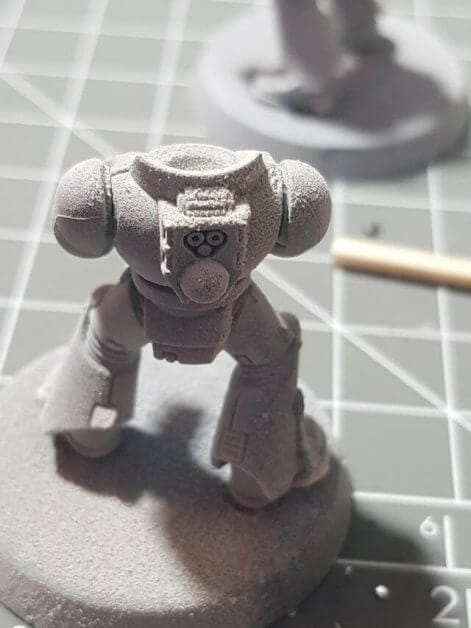
The water in the air will condense around the primer particles (as the primer atomizes) and make the primer “clump” or congeal, and even dry, before it hits your model’s surface. This creates that bumpy, undesirable texture on a bad primer job.
You can avoid these issues by using a liquid polyurethane-based primer, like Vallejo Surface Primers.
3. Cost-effective
Vallejo surface primers are a great value that will save you a lot of money.
The use of a liquid surface primer is more cost-effective than spray can primers. For the cost of a single rattle can spray primer from Citadel (Games Workshop) or Army Painter, you could buy two 60ml or one 200ml bottle of Vallejo Surface Primer.
A 200ml bottle of Vallejo Surface Primer has more than 300% more primer solution in it than a single 9.9oz can of Citadel spray primer (which is mostly solvent and propellant than primer anyway).
This ultimately means more model priming from your hard earned hobby budget when you use a Vallejo Surface Primer, as compared with spray can primers.
Best primer color for painting miniatures?
For speed painting or tabletop quality paint jobs, black or very dark colored primers work best. This is because when you want to paint fast, getting the shadows painted dark is often the slowest process when you’re painting with regular acrylic model paint. If you start with black or dark primer, you’re starting from a point where you don’t need to worry so much about shading your recessed areas on a model.
For display or normal painting of miniatures, I suggest using a grey (my favorite) or white colored primer. The reason you would want to start with a lighter colored primer is because it will help you see the details on your model better. Highlights and shadows will naturally fall on your primed sculpt as you look at it under good lighting conditions.

If you’re looking to paint with transparent inks or washes, you could use both a black and white primer applied with a zenithal highlight technique. In this approach, you undercoat with a black primer, followed by an overhead spray of white primer from above (from the zenith). This pulls out details as though a bright light source is shining down from above. This creates a gradient of primer that naturally shows you where highlights might fall on your model.
RELATED: BEST AIRBRUSH PAINTS FOR MINIATURE PAINTING
If you’re speed painting, an airbrush underpainting using high contrast black and white paint or primer is the easiest and fastest way to get miniature painted quickly without losing quality.
Best way to apply Vallejo Surface Primer?
You can apply Vallejo Surface Primer with a regular brush or an airbrush. Both methods will create a smooth surface on your miniatures. There are advantages and disadvantages of brushing or airbrushing with a surface primer, as there are for regular acrylic model paints.
My recommended thinning ratio for airbrushing with Vallejo Surface Primer is 2:1 (primer to thinner). For best results, I add primer directly to my airbrush cup, and then add half that volume of water or airbrush thinner. You’re looking for the consistency of melted ice cream or thick coffee cream.
For extra-low pressure applications (less than 20 PSI air pressure using a 0.3mm airbrush nozzle)–for when I’m priming small parts or “tiny minis”–I may add more thinner to reduce the viscosity of the surface primer even further. However, be careful when doing so. If you thin out your primer too much, it will lose adhesion and won’t stick to your miniature as well.
RELATED: VIDEO SHOWING TO BRUSH ON VALLEJO SURFACE PRIMER
Key tip: For best results, shake your primer bottle vigorously to mix the primer solution. To speed things up, use an small vortex mixer.
Brush versus airbrush
As an example of using a brush and airbrush to apply Vallejo Surface Primer, I 3D printed a “White Walker” bust (a character from the Game of Thrones TV show).
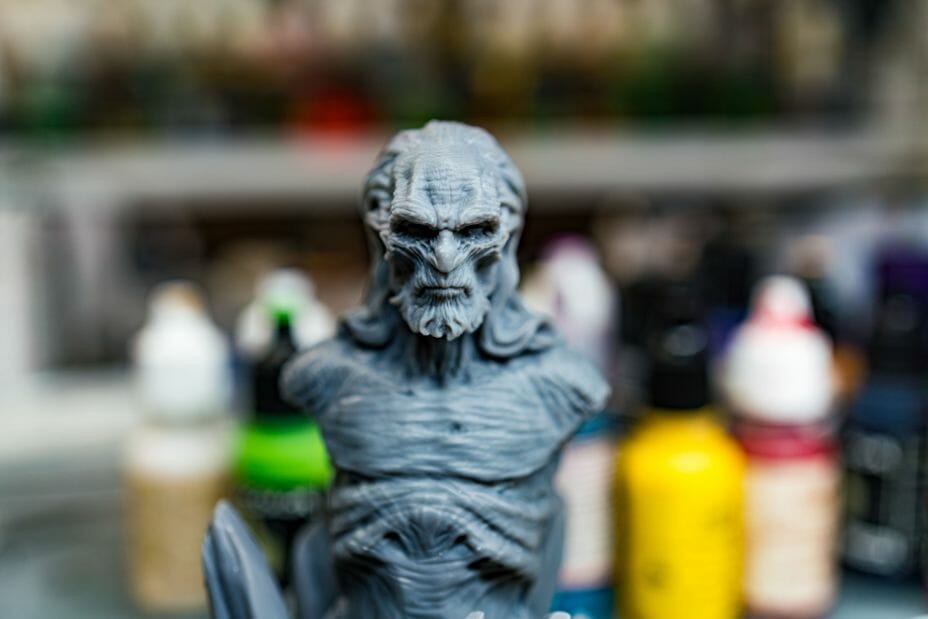
Brush application with Vallejo Surface Primer
How well does Vallejo Surface Primer work with a brush?
Vallejo Surface Primers work great when applied to models with regular brush.
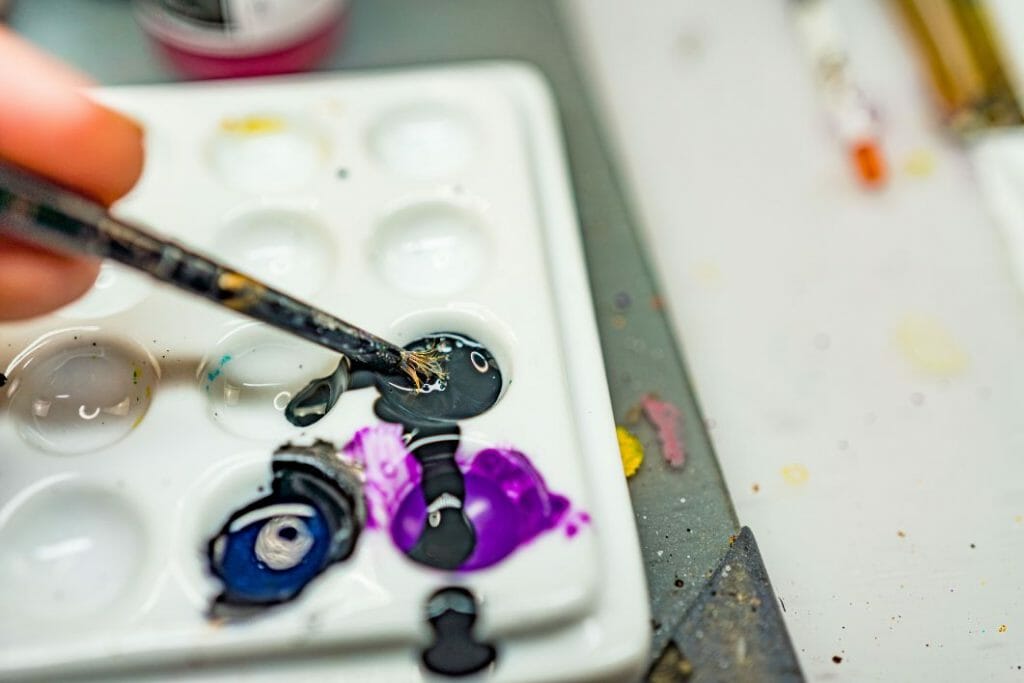
Brushing the primer on is easy. All you do is dispense some of the primer into a palette and use your favorite basecoating brush (e.g., I prefer synthetics for this job).
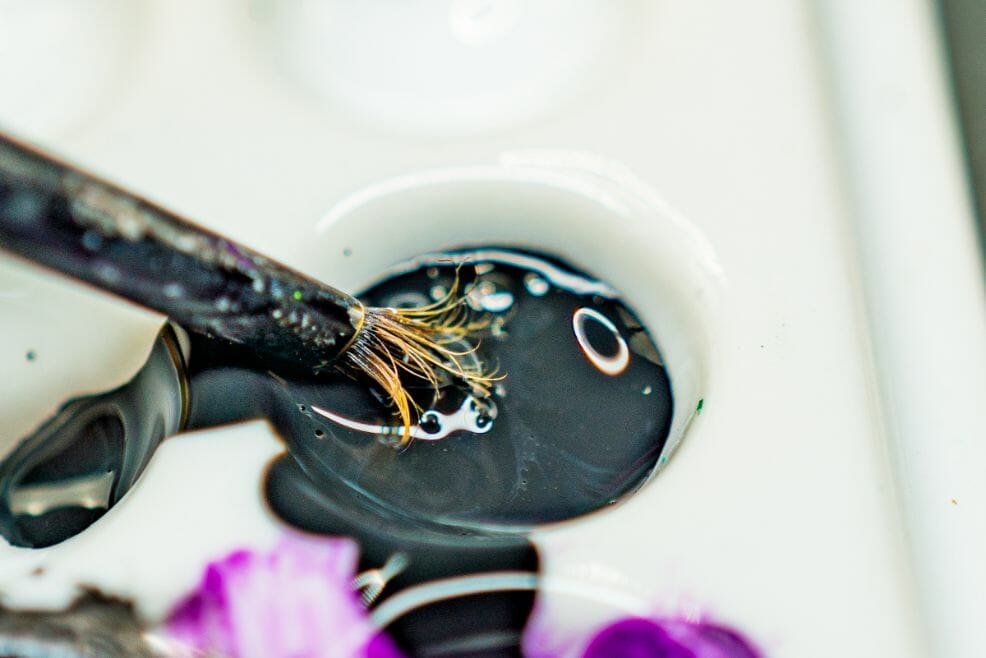
You don’t need an expensive brush for applying a surface primer. Vallejo surface primer flows nicely and mixes well with water if you need to thin it. I tend to use a drop of water to thin my primers so they go on smoothly.
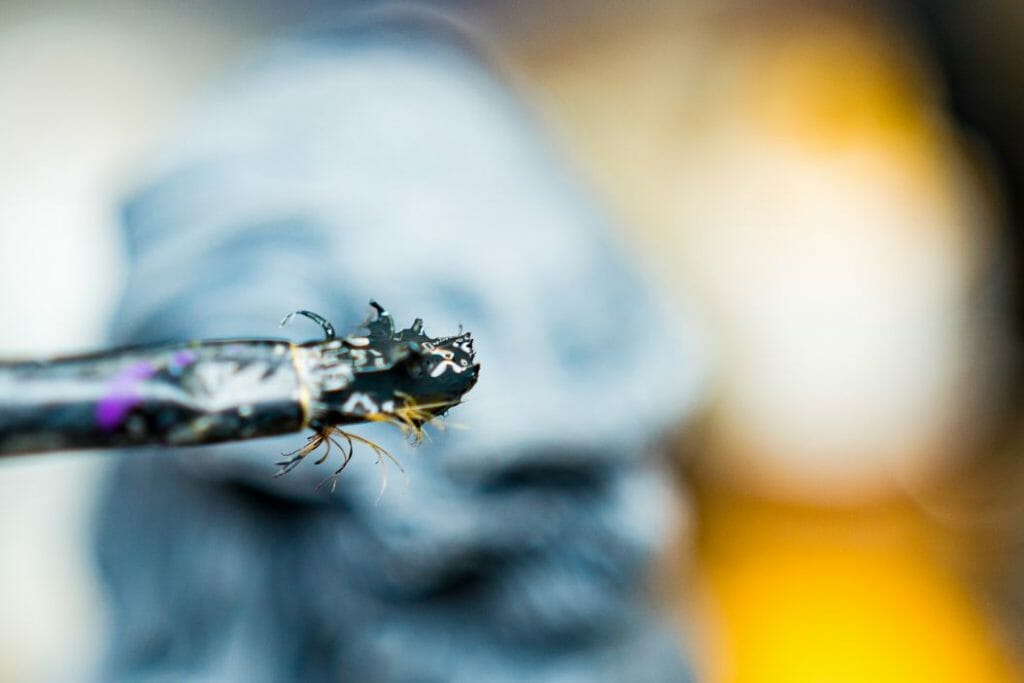
Show me an example priming with a paint brush?
Although I show my example in this review with German Panzer Grey, all the Vallejo Surface Primer colors work the same. They have a good consistency and surface tension, which makes them easy to apply.

With a brush, you can apply fairly heavy coats. Just don’t let the primer pool up in the recesses as this will block out details, but also make the primer dry too slowly. Soak up any excess primer with a clean brush, if you need to.
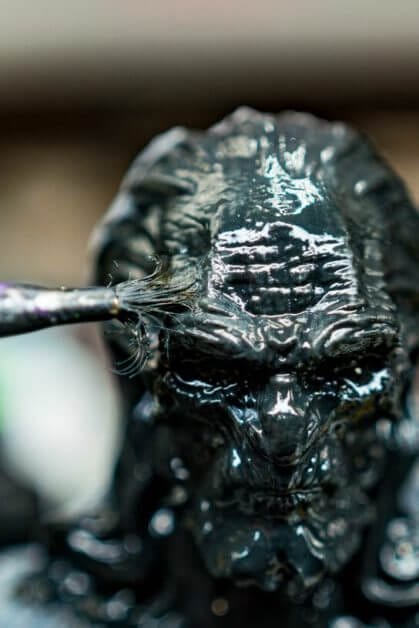
The nice thing about Vallejo Surface Primer is that it will dry into a stretched out, durable layer in an even homogenized surface. So, even if you use a thick coat of the primer, more than likely, it will still create a smooth surface, pulling itself thin as it dries.
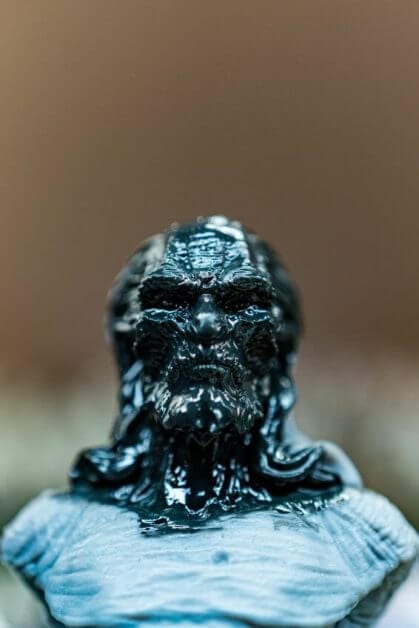
For the highly-detailed 3D prints, this is great because the Vallejo Surface Primer will allow you to use liberal applications of the primer without obscuring details. For plastic, metal, or resin kits, you will enjoy how easy it is to smoothly apply the primer with a brush.
Airbrushing Vallejo Surface Primer
How well does Vallejo Surface Primer work through an airbrush?
The best way, I think, of applying any surface primer is with a spray technique. This means that if you’re using Vallejo Surface Primer, you’ll want to airbrush it onto your model for the best results. This is because the atomized primer spray will lightly, but effectively coat your model in a smooth layer.
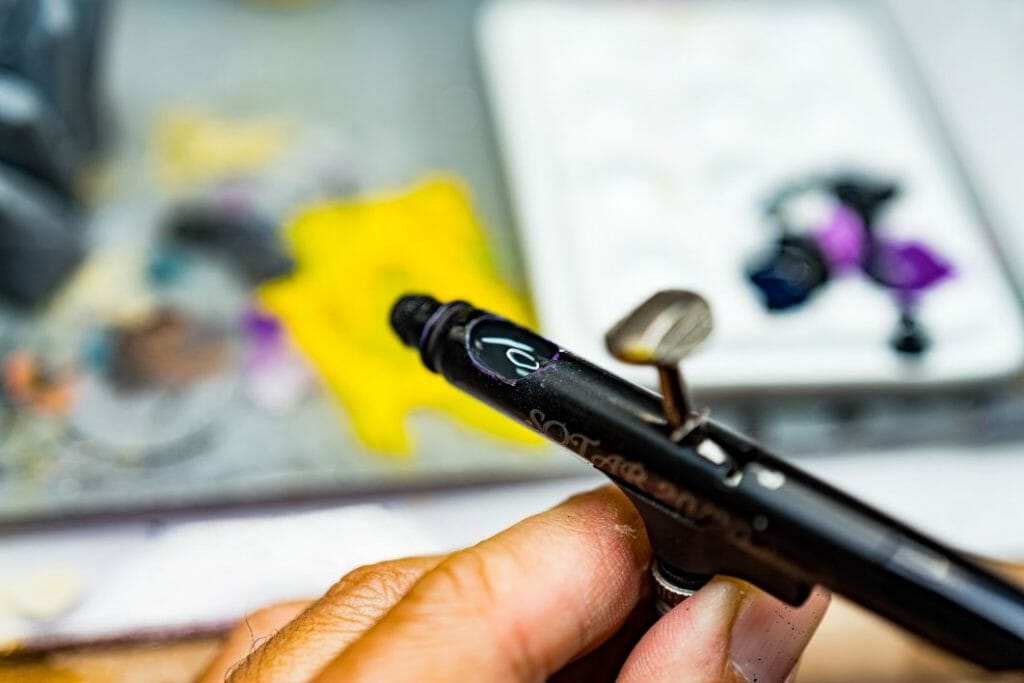
Here I used a stress test of the Vallejo Surface Primer using my Sotar 20/20 airbrush (see airbrush reviews here). The Sotar 20/20 I use has a 0.2mm nozzle, which is fairly small for airbrushing base coat layers, which are usually thick paints.
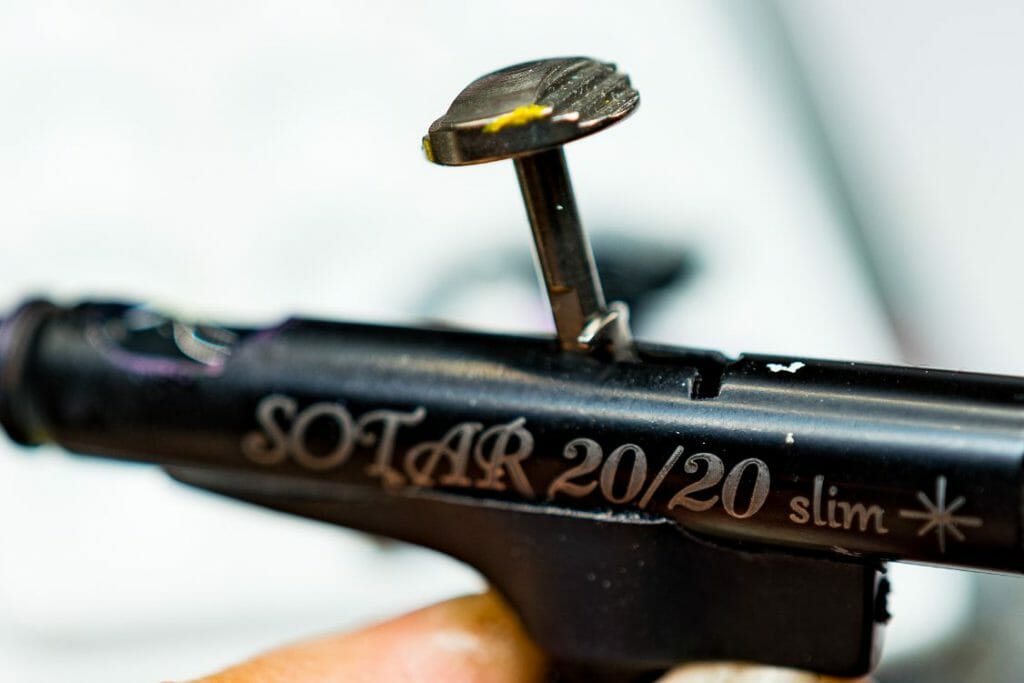
It is recommended to use an airbrush with at least a standard size 0.3mm nozzle or larger to avoid clogging.
To thin the primer properly for airbrushing, I tend to use water or a few drops of Vallejo Airbrush Thinner. The thinner is essentially a flow-improver additive that helps thin paint or primer while maintaining its binding properties so it sticks to surfaces. Sometimes with too much water, diluted paint or primer will become too running and become hard to control (e.g., leading to splattering or dripping).

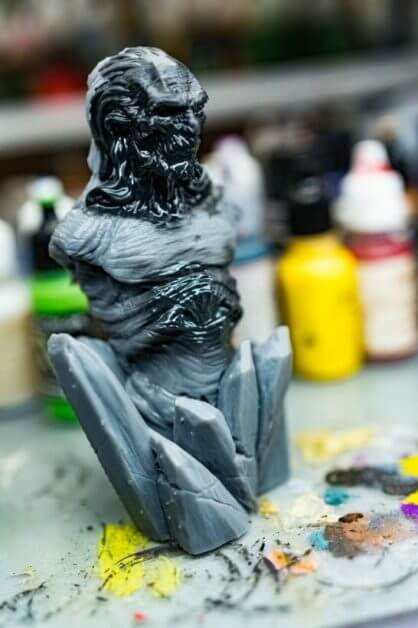
Vallejo recommends using an air compressor setting of around 15-20 PSI. This is a pretty accurate pressure in my experience too working with Vallejo Surface Primer, even in my Sotar 20/20 airbrush. You could go to a slightly air pressure if you’re using a larger nozzle like the 0.3-0.5mm nozzles on Badger Patriot 105 airbrushes, for example.
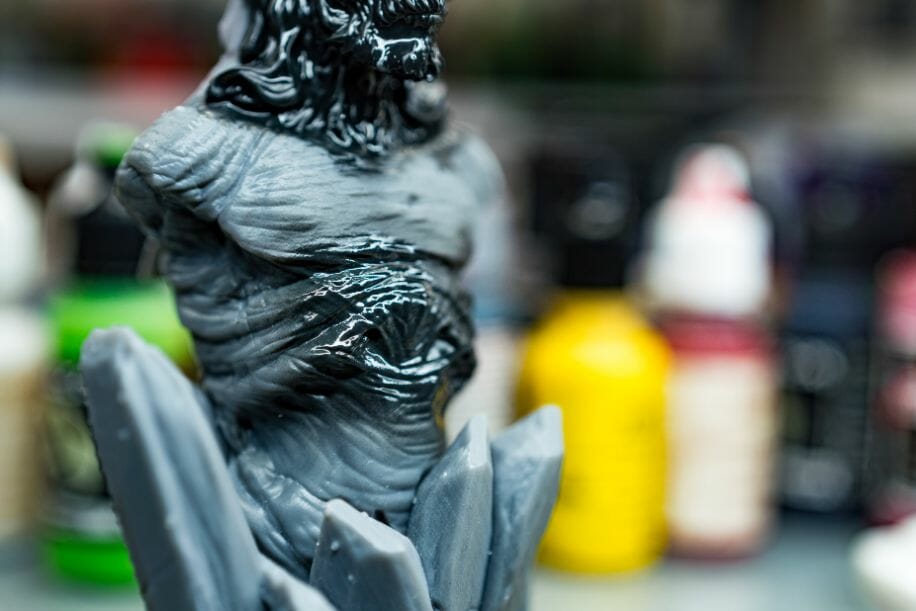
In this airbrush priming test, I sprayed a small region of the chest/sternum of the bust. As you can see from a quick airbrush burst, the primer quickly adhered to the model in a thin layer. The application was easy and fast.
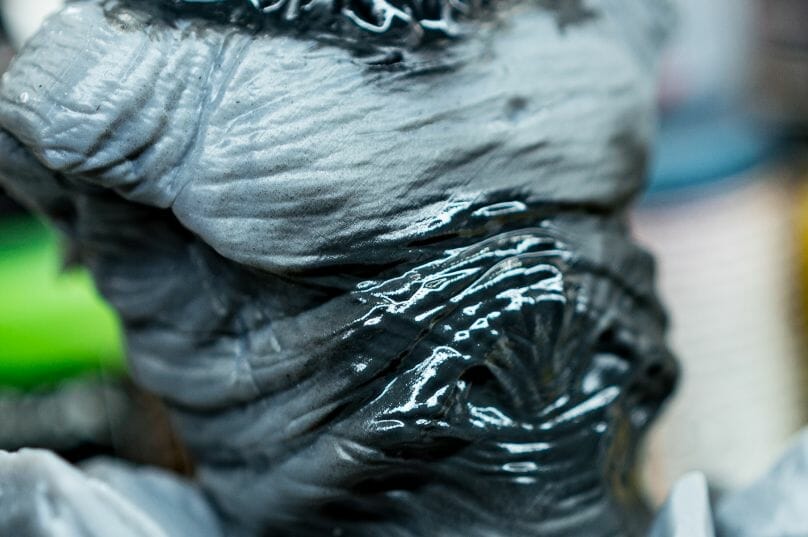
A closer looks shows how all the details are still visible. As compared with the brush application of primer, airbrushing the surface primer was not only faster, but created a much thinner surface. A notable benefit of airbrushing primer is that you don’t waste a lot of the primer on the bristles of your brush. Most of it leaves the airbrush as you apply it to a model.
Is airbrushing Vallejo Surface Primer safe?
Any foreign particles entering your lungs could be a potential hazard. Things like asthma, allergies, and other chronic respiratory diseases may be triggered by inhaling the airbrush spray of any primer.
Take precautions and use a respirator or a spray booth when you’re spraying surface primer through your airbrush.
RELATED: BEST AIRBRUSH SPRAY BOOTHS FOR MINIATURES
Note that Vallejo Surface Primers are not flammable, and do not contain solvents. Vallejo has additional documentation about the safety of their surface primer products, e.g., safety document sheet (SDS), which you can check out here.
How long should I wait for primer to dry?
You can tell when Vallejo Surface Primer is dry by looking at the color and reflection on the model. As primer dries, the color lightens and the reflections decrease (unless you’re spraying the black gloss surface primer).
From my experience, at room temperature (~25C or 70-75F) and normal humidity, it only takes about 5-10 minutes for an airbrushed primer application to dry. If I used a paint brush to apply the primer, it may take a bit longer, up to 20-30 minutes for the primer to dry. This is because a brush on application of surface primer will usually be thicker than airbrushing the primer.

Notice in the photo above how the surface primer on the head (which had the brush on application) appears to be still wet and damp, as compared with the chest and trunk section (which had the airbrush application).
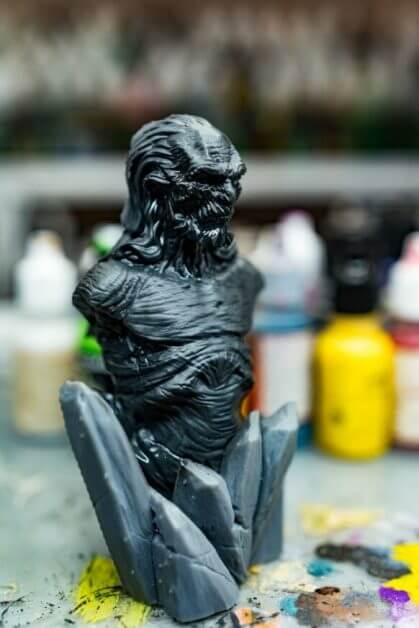
For a truly durable surface for painting, you will want to wait at least a few hours if not overnight for your surface primer to dry.
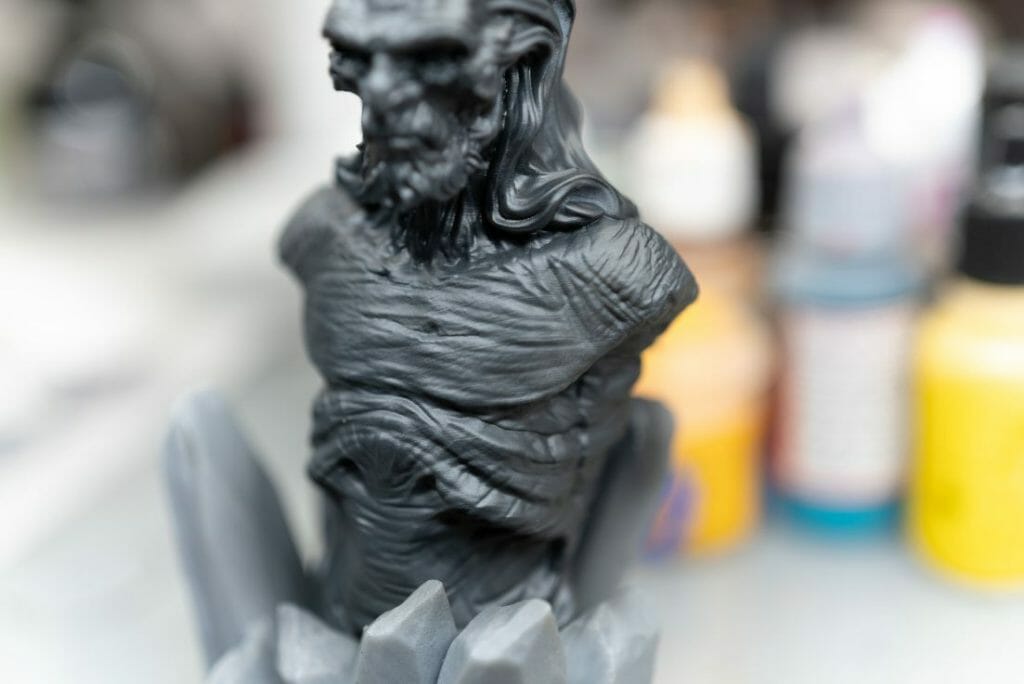
After an overnight wait, you can see how the surface primer has dried into a thin even looking surface. All the details in the model are still visible, even the 3D print lines. To cover those 3D printing artifacts, a few more layers of the surface primer can help, or you can look into use gap fillers.
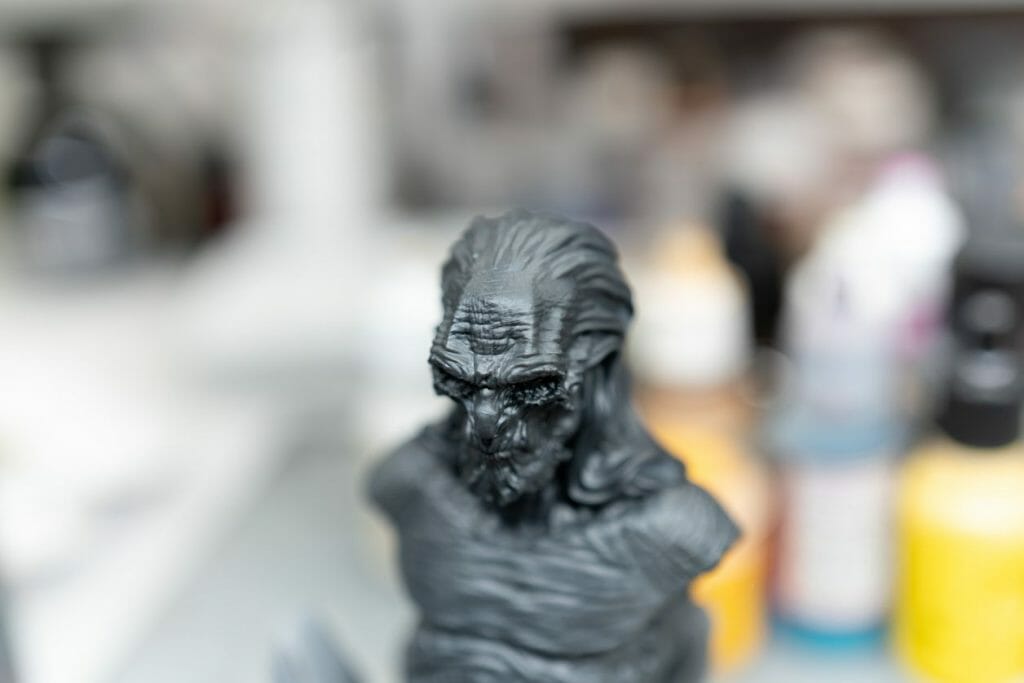
Pro tip: to speed up primer drying, you can use a hair dryer set to the its lowest heat setting. See other reasons why you may want a hair dryer for painting miniatures here.
What is better for priming: airbrush or regular brush?
An airbrush is better for applying a surface primer because it is faster, wastes less paint, and applies a smoother and thinner primer coat (which preserves model surface details).
If you don’t have an airbrush or prefer to avoid the maintenance (and potential clogging) of your airbrush when priming, a regular brush will work great with Vallejo Surface Primer (see results above). Just remember that you can thin your primer with water or thinner additives to help it flow off your brush. Make sure to avoid letting primer pool in recesses.
Pros and Cons of Airbrush Priming
Pros
- Airbrushing is faster
- Wastes less primer
- Spraying a primer preserves model surface details
Cons
- Requires airbrush equipment and accessories
- More cleaning and tool maintenance
- Potential hazard with aerosolized primer
Best alternative surface primers to Vallejo Surface Primer?
There are 2 other surface primers I recommend if you don’t want to use Vallejo Surface Primer or it is hard to find:


Both AK Interactive Primer and Badger STYNYLREZ are worthy competitors of Vallejo Surface Primer. You can use the same application techniques with any of these surface primers, either using a regular brush or airbrush. They also come in a variety of colors, though I do recommend only using one of the neutral colors, black, gray, or white (as you’ll be painting over these primers anyway).
| Product | Price and details |
|---|---|
| Vallejo Surface Primer | Check Price |
| AK Interactive Primer | Check Price |
| Badger STYNYLREZ | Check Price |
Conclusion
Vallejo Surface Primer is an amazing product for hobbyists who paint miniatures and models. The primer is easy to use, accessible, cost-effective, and safe with its intended use. You can apply the primer effectively with an airbrush or regular brush, and will get a great surface that prepares your model for model acrylic or even oil paint.
To thin Vallejo Surface Primer, you can use water or flow improver additives, such as the Vallejo Thinner. When you airbrush keeping your air pressure low (around 15-20 PSI) will help you keep control over the spray pattern.
I’ve used Vallejo Surface Primer for years for painting miniatures. I’ve gone through several 200ml bottles of the primer to paint the hundreds or even thousands of models I’ve worked on for commission and personal products. If I had used a spray can primers, I would have spent a lot of money unnecessarily.
In fact, I estimate that the money I saved using the surface primer instead of rattle can primers has easily paid off my airbrush equipment investment. You can see my recommended airbrushes for painting miniatures here or the full airbrush guide here.
Overall, I highly-recommend the use of Vallejo Surface Primer to anyone who paints miniatures or works with models large and small.
Happy painting (and priming)!



Tangible Day on YouTube (Miniatures and More!)

Thanks for reviewing this, I can’t tell you how many models I’ve left unpainted because I couldn’t find a decently thin primer. I just ordered a bottle along some other supplies I’m going to need in the near future. By the way, you should add Micro-Mark listings for any painting or modelling supplies you review. I get my supplies almost exclusively from them, and their prices are pretty good – a 200ml bottle of Vallejo primer is $15 from Micro-Mark, vs. $20 from Amazon.
Oh okay! Does Micro-Mark charge shipping?
Most of the time they do, but it’s not very much, and there is the occasional free shipping promo (usually on large orders) or other discount available.
Is this primer durable after curing or is it like the other water based acrylic paint which has tendency for being tacky or sticky? Does it cure hard or something like latex paint and can be scrubbed away easily with alcohol, water and soap? Is it as scratch prove as aerosol primer? As far as I have tested aerosol paint is more water proof than latex paint. I am generally interested in the nature this primer after curing… becos I want to paint soft PVC, and stacking (stickiness) is prone.
Vallejo surface primer (water based polyurethane) is durable, but not as resilient to abrasion as an enamel aerosol primer. With Vallejo, it dries matte/satin and not sticky/tacky. It’ll be dry to the touch. It will not rub away like latex with soap and water. But high proof alcohol can degrade it. If you’re painting PVC minis (soft plastic) Vallejo surface primer will do quite well. Apply it in thin layers. 2-3 super thin layers will be more durable than a single thick layer. Make sure you wash (soap and water to remove residual oils/debris) your plastic surface before priming.
To add to what Tangible Day just said, you CAN remove it with isopropanol, but it takes quite a bit of effort. I’ve used 99% IPA to remove bad paint jobs, and it’s not a quick process. In fact, the few times that I’ve had to remove a bad paint job, I can wipe away the top coat with one wipe, but the primer is left behind, and removing it takes a bit of scrubbing – not worth the effort if the primer coat doesn’t need to be re-done.
Thank you, this has been very helpful
You’re welcome!
Thanks for a great guide
Welcome! Thanks for letting me know you found it helpful!
Pingback: 6 Great Miniature Priming Hacks (Useful Tips) - Tangible Day
Greetings! Can I translate and repost this article to a Chinese website BiliBili? Your introduction and advice is so helpful that I really wish to share them with other people. Of course I will credit your name, blog link and other information, and it will not be used commercially.
That sounds fine 🙂
Thanks for the useful information, I greatly appreciate your time and effort on this!
Pingback: 7 Best Ways to Protect Painted Miniatures – A-Case shop
It would be super helpful if these articles had dates on them? Good info and tips, very helpful! But products often change over time, formulas get altered, and I can’t tell if this is recent or from 7 years ago.
(Disclaimer, while I did give the page a thorough eyeballing, it’s STILL possible I have looked at it 5 times and not seen it, if so, ignore this comment, lol. But if so, perhaps consider putting it somewhere more prominent, like the top of the article?)
That said, useful info here, found what I was looking for (provided it’s still accurate) Thank you!
Hi there! It’s a recent article – I’ll find out why dates still aren’t showing and get it up there. Information is constantly updated as you’re right things change over time. You’ll notice that for almost all of these guides the basic principles and core content stays constant. We will of course update things to reflect the industry and technology as it advances. Note that it hasn’t shifted much here with primers though. Vallejo surface primers, it’s utility, and other similar formulations have not changed. Nonetheless, I’m super happy you found this info helpful and I truly appreciate your leaving the comment and feedback 🙂
Hi, great article! I have been using panzer gray for a while and absolutely love it. However, recently I wanted to try priming with white and for the Vallejo white primer. Now, this one behaves completely different and is much more diluted than the gray, is that the case for you? If so, any tips on dealing with it when not airbrushing?
If you tell me the consistency should be the same then I got a bad bottle of white. I’ve had to apply more coats than the gray one.
Thanks and keep up the excellent work
Thanks!!! The white primer should be the same consistency as the gray. It’s possible that it hasn’t mixed well? I’m sure you took care of that. Hmm.
But I will say that white primers in general don’t cover as well in a single coat. And, for priming, it’s OK if your primer layer isn’t completely covering the underlying surface. Streaks are okay, as long as it dries smooth and isn’t bubbly or lumpy.
Let me know how it goes 🙂
gL!
Thanks for your answer! I did shake the bottle well and made sure I couldn’t see any sediments on the bottom of the bottle. I will try again and will not worry about streaking, I rather not apply too many coats of primer.
You’re welcome! Please let me know how it goes. Indeed, less primer works better 🙂
Newbie here trying to understand the whys. Several crazy basic questions: If a primer “ensures that paint adheres to the surface and helps paint durability,” why does it have an advantage over paint when it comes to adhering to a surface? I thought a primer (or base coat) is basically a layer of paint. What makes it have super powers that paint does not? Why not make paint have the same properties as a primer to avoid the need for it? To me, adding a layer of paint/primer would reduce the detail on such small pieces like miniatures because it would fill the cavities.
Hi, thank you for your comment. A primer is different chemically than I paint in particular for hobby primers, they are formulated to thin out when they dry and stretch over a surface to retain surface texture and detail primer like Vallejo service primer also have a microscopic texture to them and provide “grip“. Many hobby paints on the other hand do not have such a formula, and tend to be “slippery“ which helped them flow off your paintbrush, as well as blend easier. Inde, there are some paint and primer combos all in one formulas, but these are rare in the hobby paint space, and they tend to be much thicker than standalone, primers or paints. Ultimately just comes down to formulation and the character of how the media works if you dig into the literature a bit, you’ll find that even car manufacturers use a primer, a standalone application that sticks to the metal of the surface of a car, and then they apply a paint over that primer. In cosmetics, you would apply a primer before applying make up. The primer evens out the surface of the skin, preventing oils from the skin from mixing into the make up. At the end of the day, primer serves its own purpose that is very distinct from paint.
Thank you. It’s always the small things that are taken for granted but never explained that make you second guess why they are. I’ve used primers in home remodeling, but I’ve never understood the whys of it. If only the hardware store or heck, even This Old House would have mentioned the why at some point in a clear way as you did, I would have had a better idea.